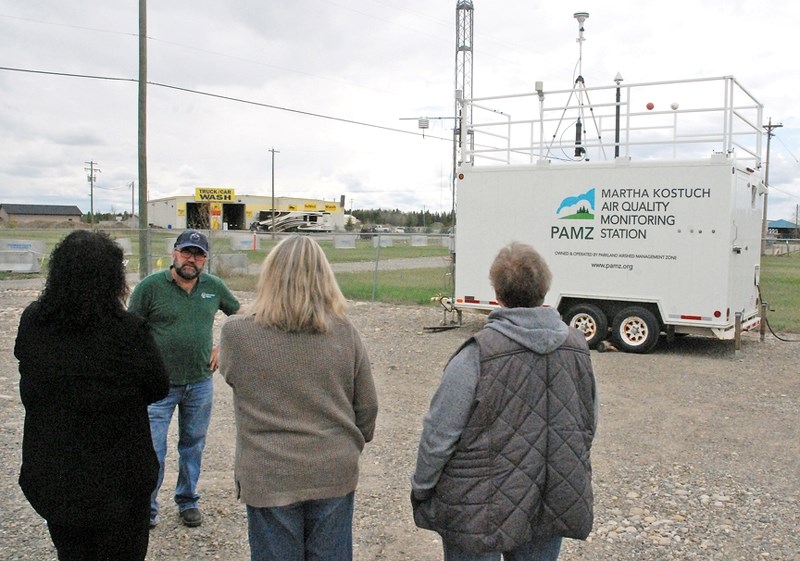An air quality watchdog recently set up a monitoring station in Sundre to gauge the amount of fine particulate matter floating around in the area.
Following a request last August from the South McDougal Flats Area Protection Society, the Parkland Airshed Management Zone (PAMZ) was able to allocate a mobile trailer equipped with an array of sophisticated scientific tools that will offer a glimpse into the local air's condition.
"What this station is for is for going out and collecting data to help us better understand air quality issues, but also to help build a geographic database," said Kevin Warren, PAMZ executive director, during a mid-May walk-through of the trailer with several members of the society.
Put in place behind the Town of Sundre's main office in early May, the unit acquired samples for a month.
"Then we'll come back in October and do a second month of monitoring," Warren said.
Analyzing the air quality is a function of two main elements ó what kinds of particles are ending up in the air, such as for example dust from gravel operations, as well as how those emissions behave once they're in the atmosphere, he explained.
"If you want to understand air quality, you got to measure what's in the air."
The array of data the monitoring station gathers and compiles includes wind speeds and directions, relative humidity, temperature, as well as of course fine particulate matter, he said.
"There was a saying when I was in school that the solution to pollution is dilution," he said. "That's how we used to think. We don't think that way anymore because we've now come to the realization that the earth has a finite carrying capacity. We think about things in terms of cumulative effects."
Fine particulate matter refers to particles that are smaller than 2.5 microns in diameter. To put that in perspective, Warren pointed out that a typical human hair is 60 microns. In other words, fine particulate matter is not even visible to the naked eye, although cumulatively the fine particles create a haze.
"We're concerned about that size fraction because it gets past the little hairs in your nose, it doesn't get washed down your throat ó it goes down right into your lungs."
However, gravel dust creates particles that are much larger than 2.5 microns, he said.
"You can see them, you can feel them. They're a nuisance, they coat everything."
If the samples analyzed by the monitoring station should yield a result that exceeds a pre-defined air quality objective of 100 micrograms per cubic metre, PAMZ will do further analysis, he said, adding that Alberta Environment in that case would also be informed.
"We don't enforce any regulations ó we're kind of a watchdog," he said.
"We might propose actions or strategies, but it's not us that would implement themÖAll we're trying to do is better understand the issue."
A response would generally come from stakeholders or municipalities. The province could even potentially mandate that any responsible companies take action, he said.
"Alberta Environment is the regulator here."
However, the next steps can only be taken once the study is complete, he said.
PAMZ's boundaries in the province encompass a 42,000-square-kilometre area of West Central Alberta, reaching about as far to the northwest as Jasper National Park, southwest to Banff National Park, and as far to the northeast as past Ponoka, as well as near Three Hills and Crossfield in the southeast.
"The data we collect is vital to our understanding of air quality in the zone. The data is also the foundation for planning, initiatives and action to keep our air breathable," the group's website says.
"When you think about 260,000 people ó their vehicles, workplaces, livestock, furnaces and campfires ó all sharing our thin layer of air, the quality of what we breathe suddenly seems important, doesn't it?"
Visit www.pamz.org for more information.
"Air quality was one of the concerns identified on our initial survey by our members when we started the society," said Robin Tudor, co-founder and president of the South McDougal Flats Area Protection Society.
"We are hoping to get at least a baseline of the air quality in the McDougal Flats area, which the Town of Sundre is situated within. The wet spring and low activity has so far made the dust visibly much lower than previous years. Since we only have a limited time of monitoring, we might miss the heavy dust events, but we now know that air quality monitoring is available when concerns are raised."



